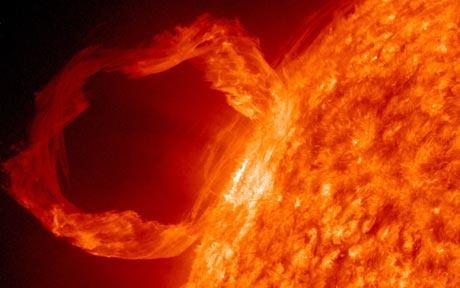National Aeronautics and Space Administration
Marshall Space Flight Center
Solar History Timeline
The Modern Era of Solar Physics

NASA-SDO/AIA
1939 - J. Dellenger describes how short wave outages caused by solar flares acting on the ionosphere.
1939 - Proton aurora discovered.
1940 - Easter Day shortwave disruption by major flare. The term 'radio blackout' first appears in a New York Times article on January 14.
1941 - Major shortwave disruptions during World War II activities.
1943 - Sunspots hamper radio transmission of Allied invasion of Italy on September 3.
1942 - S.E. Forbush detects Ground Level Event (GLE) radiation enhancement due to energetic protons associated with a solar flare.
1947 - World-wide radio traffic is blacked out by a 'sunspot' on March 8th. Radio fadeouts are reported over Shannon Airport in Ireland on July 19th Airplane radio traffic interference is extensive but no blackouts during July 20th storm. Radio blackouts across the Pacific Ocean and extending to New York are reported during the August 23 storm.
1947 - Giovanelli proposes that solar flares related to solar magnetic changes.
1949 - Astronomer Grote Reber detects a major radio burst from a flare, 3 minutes before the actual flare is detected by telescopic study.
1951 - L. Biermann discovers solar wind using comet tails.
1953 - Dungey proposes that solar flares caused by opposing magnetic fields on the sun.
1956 - P. A. Sweet proposes that flares originate in the activity of magnetic fields above the active areas of sunspots.
1957 - Waldmeier discovers coronal holes.
1957 - Hannes Alfven proposes that the solar wind was magnetized.
1957 - World-wide radio fadeout lasts several hours on April 16th. A 36-hour blackout cripples England on June 20th.
1958 - Van Allen Belts discovered by Explorer I satellite.
1958 - Severny proposes magnetic shock wave theory of flares, and that flares occur along the magnetic 'neutral line'. Sweet develops a 'flux interchange' theory which shows how the flaring process leads to a simpler-shaped field after the flare event.
1958 - Eugene Parker predicts solar wind should exist.
1959 - Shortwave blackout over North Atlantic on March 29th . Shortwave blackout over Asia, Europe and North America on August 18th.
1959 - Mariner 2 spacecraft detects the solar wind.
1960 - Tommy Gold and Fred Hoyle propose that all of the energy released in a flare was previously stored in a magnetic field.
1960 - Moreton observes time-lapse solar activity which shows that a flare explosion produces waves in the solar atmosphere much like a bomb's concussion wave, and that these waves travel at 1000 km/sec and sometimes cause other solar disturbances in their wake.
1961 - Magnetopause boundary detected by Explorer 10 spacecraft.
1962 - Warwick discovers Polar Cap Absorption events, and shows how these are related to powerful solar flare proton streams with energies of 10 MeV.
1963 - Eugene Parker calculates how magnetic reconnection might work in a solar flare, and concludes that it takes too long to explain the sudden changes seen in typical solar flares.
1963 - Type IV radio flares are found to be related to proton acceleration. Magnetic reconnection theories get a reprieve.
1963 - Furth proposes a new 'tearing mode' which disrupts current sheets and leads to solar flares. The time it takes reconnection to happen is an average time between the Parker and Petschek processes.
1964 - Using a more detailed approach to describing magnetic reconnection than what Furth used in 1963, Petscheck recalculates how Parker's reconnection process would work, and concludes that reconnection could easily happen as fast as actual flare events are observed.
1967 - Alfven and Carlquist propose a 'current disruption' process which can also act very quickly, but makes different assumptions than what Parker and Petschek made in describing the release of magnetic energy.
1968 - OGO-5 satellite detects magnetic activity in the geotail region.
1968 - Bumba shows that flares have a statistical preference for active regions where two bipolar spot groups are merging, with one developing in the central regions of another.
1968 - David Rust confirms that explosions occur at neutral points in magnetic fields of sunspots and satellite spots. The vanishing magnetic energy is equal to the kinetic energy of the gases and the electromagnetic energy in x-rays and gamma rays. These observations seem to confirm the Parker/Petschek reconnection idea.
1971 - Najita and Orrall and Hudson propose that white light flares are caused by bombardment of the upper photosphere by down-streaming proton or electron beams from the site of the flare event in the top of the coronal loop.
1971 - Lin and Hudson propose that hard X-ray bursts during the impulsive phase of a flare are evidence for 10,000 to 100,000 volt electron beams.
1971 - Brown proposes the 'non thermal' flare model where magnetic energy causes an electrical current to flow down a magnetic loop until it collides with the photosphere at the footpoints, and heats the gases to x-ray energies to cause the flare.
1971 - OSO-7 satellite discovers 'Coronal transients.'
1972 August 4 - Apollo 17 major flare
1974 - Altschuler shows that the coronal magnetic field changes drastically in strength and geometry around a flare region. Low level magnetic loops disappear and this means that currents of electricity also disappear at the time of a flare.
1989 March - 8-13 Major solar flare, X15 - Space Shuttle pressure sensor malfunction reported, but then sensor returns to normal so flight not aborted.
2001 April 2 - Solar flare X20 - major flare
2003 November 4 - Major solar flare X34 ends a period of solar storms which began October 28th. Astronauts on the International Space Station take cover. Many newspaper accounts.
2003 November 11 - Solar flare reproduced under laboratory conditions by a team of scientists at the Culham Science Centre near Oxford, England.
The Origin of the Cosmos, Earth, Sun, and Humans
The Modern Era of Solar Physics
- NASA Contact: Adam Kobelski
- Page Last Updated: Monday, 01 October 2012

